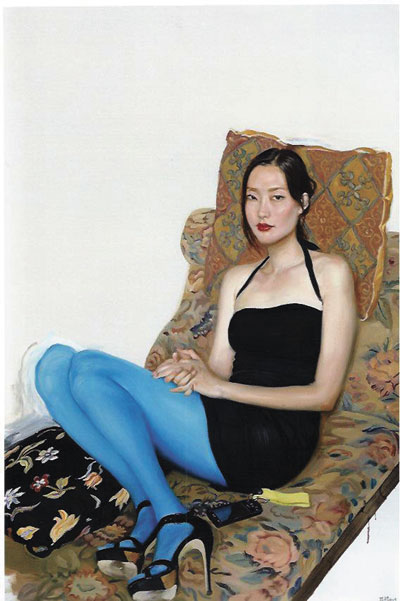
Cao Zhen
caozhen0806@126.com
AN exhibition presenting portraits and interiors created by Chen Danqing and Mao Yan from China and Jan Worst and Philip Akkerman from the Netherlands is being held at He Xiangning Art Museum, triggering an intercultural dialogue with contemporary contexts.
In the exhibition, titled “Face 2 Face,” each artist has a unique individual approach and style. Chen’s portraits use natural realism to casually examine the environment and people’s body language. Worst’s characters are lost in gorgeous interior spaces and movie-like lighting. Akkerman displays self-portraits from more than 30 years, interpreting his own differing faces and identities through realism and cubism. Mao also repeatedly portrays the same person, but not through self-portraits. He uses a single color to repeatedly paint a Caucasian man’s face, capturing intrinsic spirit rather than identity.
“Portraits and interiors are two traditional and intriguing themes in art history. The exhibition is a dialogue between the four artists and the two countries because the artists all have a passion for portraits,” said Dutch curator Cees Hendrikse at the July 6 opening. Hendrikse is a collector of Chinese and Dutch contemporary art.
Chen’s work at the exhibition includes portraits he painted in China and the Netherlands in recent years. The 60-year-old painter and social critic earned instant fame as a leading realist in the 1980s for his “Tibetans” oil painting series.
His work features Chinese students in Beijing and ordinary Dutch people in The Hague. Models in plain studios are vividly portrayed through their clothes, belongings and facial expressions, echoing the duality of traditional and contemporary China. Chen said his realist style was influenced by European paintings in the 19th century, and especially by French artist Gustave Courbet.
“Chen portrays people in a forthright way. In his paintings of Chinese people, I see the social changes in the country. His portraits of Dutch people create a sense of accuracy, giving figures life,” Hendrikse said.
Chen also painted a portrait of Akkerman, who has only painted himself since 1981. Among Akkerman’s 3,350 self-portraits, 63 are exhibited here, chronicling his stylistic changes over the past three decades.
Hendrikse said Akkerman originally painted himself in a traditional way with the help of a mirror, but later only used his imagination. The use of color and dynamics of lines change significantly in his self-portraits.
Chen said Akkerman uses simple methods to explore every possibility of painting. “He doesn’t have to adjust himself to different models. He just tries all styles deeply on his face,” Chen said.
Mao also sticks to painting the same person. His model is Thomas Rohdewald, a Luxembourg student whom Mao met in Beijing in 1999. Creating frosty hues, Mao, 45, reduces color and paints almost monochromatically, but sensitively portrays the model’s face.
“Thomas is only the body. Actually, I am painting my psychological states at particular times,” said Mao, who graduated from the Central Academy of Fine Arts in Beijing in 1991.
Worst tackles interiors and, specifically, people inside those interiors. His works evoke artists from the Dutch and Flemish Golden Age in their portrayal of lavish interiors full of books, furniture and tapestries. Amid the excessively decorated backgrounds, one or two people act as lonely figures, creating theaters for human agony.
Worst falls between rigid academic painting and modern art forms that appropriate everything they can use. In his paintings, naked or well-dressed women and curious children are seen in libraries or on desks. Worst said instead of using real models, his figure inspirations come from fashion magazines, and the settings are influenced by Italian films in the 1960s, including works of Michelangelo Antonioni and Federico Fellini.
“Worst’s paintings are about human communication. When spectators observe his paintings, they are often curious about what the figures are doing and the relationship between them. A painting that raises questions is a good painting,” Hendrikse said.
Worst refuses to decode his works, insisting he’s a painter, not a storyteller. Chen agreed that painting is a very personal thing.
“In the past, painting has had social meaning or helped spread religion, but now painting is only a self-amusing work. Many Chinese painters like to emphasize the social meaning of their works, while Westerners do not,” Chen said.
Dates: Until Sept. 8
Hours: 9:30 a.m.-5 p.m. Closed Mondays
Venue: He Xiangning Art Museum, Overseas Chinese Town, Shennan Boulevard, Nanshan District (南山区华侨城何香凝美术馆)
Metro: Luobao Line, OCT Station (华侨城站), Exit C
|

